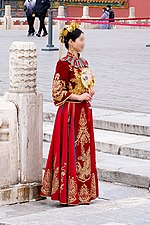Xiuhefu
 | |
| Type | Traditional Chinese wedding dress in aoqun fashion |
|---|---|
| Place of origin | China |
Xiuhefu (Chinese: 秀禾服) is a two-piece garment set of attire which was designed to look like a style of traditional Chinese wedding dress and follows the traditional Chinese yichang clothing system. The Xiuhefu is a modern recreation version of the Qing dynasty wedding aoqun, a form of Hanfu, which was worn by the Han Chinese women,[1][2] composed of a qun as lower garment and an ao as an upper garment.[3] It was developed in modern China and became popular in 2001 when it was popularized by when Zhou Xun, the actress who played the role of Xiu He, in the Chinese television drama Juzi Hongle(橘子紅了; 'Orange turned red'), thus gaining its contemporary name from name of the television drama character.[1][2] It is often confused with another traditional Chinese wedding dress known as qungua due to their similarities in appearance.[3]
Origins
The direct precursor of the Xiuhefu originated from the Qing dynasty-style wedding aoqun which was worn by the Han Chinese women,[1][2] composed of a mamianqun (a specific type of qun) as lower garment and an liling dajin changao ao as an upper garment.[3][2]
In 2001, the prototype of the modern Xiuhefu was a guzhuang-style wedding dress costume which was designed by costume designer Ye Jintian for the role of drama female character Xiu He, played by Chinese actress Zhou Xun, in the 2002 Chinese television drama Juzi Hongle (橘子紅了), also known as Ripening Orange in English,[4][5] a drama set in the Republican era of China.[6] The wedding dress costume worn by Xiu He, thus, became known as Xiuhefu.[7] While basing himself on the clothing of the Qing dynasty, Ye Jintian, however, did not fully respected the historical accuracy of the dress and instead mixed several elements together from similar eras in his costume design.[6]
As it gives a feeling of dignity and beauty, the Xiuhefu designed by Ye Jintian became progressively popular and eventually became a form of wedding dress chosen by brides during their marriage.[7] It especially became popular among several Chinese female celebrities.[8]
Construction and design

In general, the design and construction of the Xiuhefu is not bound by any traditional clothing making rules.[1] However, as a set of attire, it follows the traditional yichang system being typically composed of a waist-length liling dajin ao, a form of ao (a form of Chinese coat) which has front lapel overlapping across the chest and closing on the right side with a liling (lit. 'standing collar'), and a long-length qun, which looks similar to a mamianqun as it is one of its derivative.[3] The upper garment is not always a liling dajin ao; it can also be a yuanling ao, which is an ao with a round collar.[7] The sleeves are horn sleeves, which are relatively wide; the sleeves can sometimes be double-layered.[7]
Mamianqun
The qun used in the Xiuhefu is influenced by the historical mamianqun of the Qing dynasty, especially those used in the late years of the Qing dynasty in the 1910s,[1] which was used as part of the bridal attire.[2] This wedding skirt is also called mamianqun.[3] The mamianqun used in the Xiuhefu can either be an A-line, pleated skirt[3] or a pleated circle skirt.[1][9] It has panels of flat fabric, which is embellished with decorative designs which uses an embroidery technique known as Chaoxiu (Chinese: 潮绣; lit. 'Chao embroidery').[3] Compared to the historical mamianqun which has qunmen (裙门; 'skirt door') or mamian (马面裙; 'horse face') created by the overlapping characteristics of the skirt, the flat and straight panels of fabric used in the Xiuhefu are added on top of the pleated skirt, like a pendulum; it can also have more than two visible flat panels.[1][9] The skirt is long enough to touch the top of its wearer's feet.
Embroidery
The Xiuhefu is typically embroidered with flowers (e.g. peonies[7]) and birds (e.g. peacocks[7]) to symbolize love for whole seasons.[2] It can also be embroidered with pairs of butterflies, and auspicious Chinese characters.[7]
Related content
See also
Gallery
References
- ^ a b c d e f g "Xiu He Fu | Traditional Chinese Wedding Costume". Jin Weddings. Retrieved 2022-08-09.
- ^ a b c d e f Li, Yuling (2019). New meaning in traditional wedding dresses – Xiu He Fu and Long Feng Gua – in contemporary China / Li Yuling (masters thesis). University of Malaya.
- ^ a b c d e f g JNTT (2020-07-30). "SAME SAME BUT DIFFERENT". The Red Wedding. Retrieved 2022-08-09.
- ^ Ju Zi Hong Le (Drama, History, Romance), Beijing Bainian Zhongshi Yingshi, 2001-07-08, retrieved 2022-08-22
- ^ Ho, Wing Shan (2015). Screening post-1989 China : critical analysis of Chinese film and television (First ed.). New York, NY. ISBN 978-1-137-51760-9. OCLC 898206188.
{{cite book}}: CS1 maint: location missing publisher (link) - ^ a b "Chinese wedding dresses: Are we wearing cultural heritage or inventions of film and television dramas?". iMedia. 2022-08-18.
- ^ a b c d e f g "What is the difference between Xiuhefu and Fengguanxiapi?". iNews. 2022-08-18.
- ^ "3 Types of Wedding Dresses in Costume Dramas - 2022". www.newhanfu.com. 2022-06-10. Retrieved 2022-08-22.
- ^ a b "Xiuhe cheongsam, a wedding dress, Xu Yishiqing". iNews. 2021-02-17.
- CS1 maint: location missing publisher
- Articles with short description
- Short description is different from Wikidata
- Articles containing Chinese-language text
- Pages using multiple image with auto scaled images
- Articles containing simplified Chinese-language text
- Chinese traditional clothing
- Marriage in Chinese culture
- Wedding dresses
- Chinese embroidery


